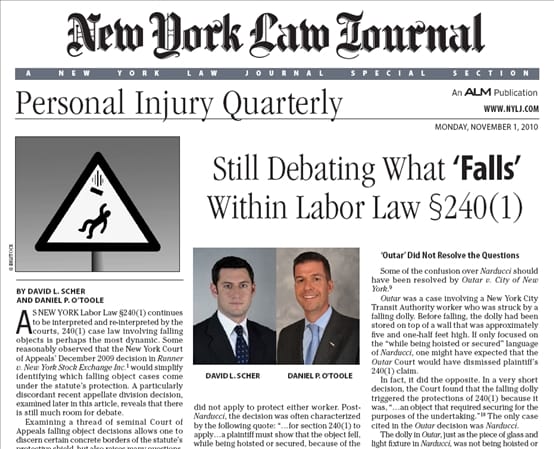CONSTRUCTION ACCIDENT ATTORNEYS DEBATE WHAT ‘FALLS’ WITHIN LABOR LAW SECTION 240(1)
The New York Law Journal
On November 1, 2010, the New York Law Journal featured an article by two of Block O’Toole & Murphy’s construction accident attorneys: David L. Scher and Daniel P. O’Toole. In the article, the attorneys discuss New York Labor Law Section 240(1) and which falling object cases are covered by this statute. According to Scher and O’Toole, there is still room for debate on this issue, although many thought that the December 2009 decision in Runner v. New York Stock Exchange Inc. would simplify identifying which falling object accidents were covered by Section 240(1).

Both experienced construction accident lawyers, Scher and O’Toole begin by discussing a landmark 2001 decision in Narducci v. Manhasset Bay Associates in which two cases were reviewed, both involving workers injured in similar falling object accidents. The first case involved a worker who was on a ladder removing window frames when he was hit by a falling piece of glass. In the second case, the worker was on a ladder installing a light fixture. Upon resting the fixture against the edges of a dropped ceiling grid, the worker began to climb down the ladder when the fixture started to fall. As he reached to stop the fixture, he cut his hand and wrist. The Court found, in a unanimous decision, that 240(1) did not protect either worker.
After reviewing the court’s decision, Scher and O’Toole proceed to discuss Outar v. City of New York, a case which they believed should have resolved some of the confusion over Narducci. In Outar, a NYC Transit Authority worker was hit by a falling dolly, which was stored atop a 5-and-a-half foot wall. Scher and O’Toole mention that if the court focused on the “while being hoisted or secured” language, it was very possible that the claim would be dismissed. However, the court found that this accident fell under the scope of 240(1) because the dolly was “an object that required securing for the purposes of the undertaking.”
Scher and O’Toole then discuss a clarifying decision in Quattrocchi v. F.J. Sciame Const. Corp., a case involving a carpenter who was hurt when he bumped into a swinging door during a delivery. In this case, several planks, which rested above the door, fell approximately two feet and hit the worker. The planks were placed on top of the doors to temporarily support an air conditioner. Just as in Outar, the court found that section 240(1) applied to the accident, though there was “an issue of fact to be determined by a jury.” The first sentence of this decision read: “[a]s our holding in Outar v. City of New York indicates, ‘falling object’ liability under Labor Law 240(1) is not limited to cases in which the falling object is in the process of being hoisted or secured…”.
Scher and O’Toole then provide an overview of Runner v. New York Stock Exchange Inc., a case involving several workers who were injured while moving an 800-pound wheel of wire down a set of stairs. The defendants in this case argued that the plaintiff did not fall or have an object fall on him and thus, 240(1) was not applicable; still, the court ruled in the plaintiff’s favor. After describing the court’s decision and role of gravity in the case, Scher and O’Toole note: “Runner dispelled the notion that cases falling under the ambit of 240(1) can be neatly and comprehensively categorized into ‘falling worker’ and ‘struck by a falling object’ cases. Runner also appeared to clarify that a significant height differential between the worker and falling object is not necessary to find liability under 240(1).”
Scher and O’Toole begin the last section of the article by posing the question: “What significance do Narducci and its progeny have in the wake of Runner?” The attorneys discuss a recent First Department decision, Makarius v. Port Authority of New York and New Jersey, which revealed that there is still room for debate on which falling object cases are covered by 240(1). Scher and O’Toole pinpoint the complexity of 240(1) falling object law in the article’s final sentence: “Within the same appellate division decision, one Justice refers to a Narducci holding as a clear continuing precedent, while another deems the decision no longer viable.”

